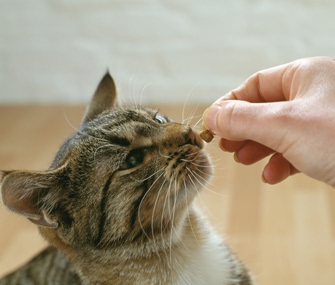Cats with diabetes can live a relatively normal life, depending on the severity of the disease when first diagnosed. Some cats are diagnosed in the early stages of diabetes and don’t require medication, as long as their diet is altered accordingly and their health is monitored and maintained. However, not all cats are that lucky and in addition to a change in their diets, they will also need oral diabetic medications or insulin injections, usually twice a day. It will take some time for both you and your cat to settle into the new routine of medicine bottles and possibly insulin injections, not to mention choosing a new diabetic cat food.
Fortunately there are many cat foods that have been specially formulated with diabetes in mind, such as the Pro Plan® Veterinary Diets DM Dietetic Management® Feline Formula by Purina®, Hill’s® Prescription Diet® m/d® Feline, and Royal Canin Veterinary Diet® Feline Glycobalance®. Most of these have dry (kibble) or wet (canned) options available. There are also a few commercially available cat foods that are grain free and low in carbohydrates that may be suitable for your cat upon consultation with your veterinarian; one example is ACANA Wild Prairie Cat & Kitten. Of course, as diabetes can affect the kidneys, it is usually recommended to feed the “wet” canned food whenever possible, but if you decide to feed the “dry” kibble instead, make sure that there is always fresh, clean water available for your cat to drink.
Once you have chosen the appropriate cat food (the one your cat likes of course!), how do you know if it is working? The most obvious sign will be that your cat appears happy and healthy again. However, this can change over time, as there are often other disorders associated with diabetes, like pancreatitis and urinary tract infections (UTI’s). It is also important to keep in mind that diseases of the kidney, thyroid and adrenal glands can interfere with the treatment of diabetes, and risk factors like obesity and insulin resistance can play a role in how your feline companion progresses with the management of their diabetes.
To really know if your cat’s new diet is working, periodic blood and urine samples will need to be sent by your veterinarian for laboratory analysis. However, as part of the home monitoring process, you can stay one step ahead of the periodic laboratory tests, by performing a weekly urine test in the comfort of your home. By using a veterinarian recommended, do-it-yourself urine analysis and monitoring kit like CheckUp, this couldn’t be easier. With CheckUp, you will be able to monitor your cat’s urine for the presence of glucose, protein, nitrate and blood. These four parameters could alert you to the following:
- Glucose – if glucose is present, then your cat’s diabetes is no longer under control. On the other hand, if it is consistently negative, this is a good indication that the treatment and diet are working.
- Protein – protein presence could indicate inflammation and damage or disease in the urinary tract.
- Nitrate – if nitrates are detected, it is highly likely that your cat has a UTI.
- Blood – blood in the urine is never a good sign and could indicate disease or damage in the urinary tract.
By using this quick and easy kit, you can monitor your cat’s disease and progress within minutes. Checking is caring. So CheckUp.







